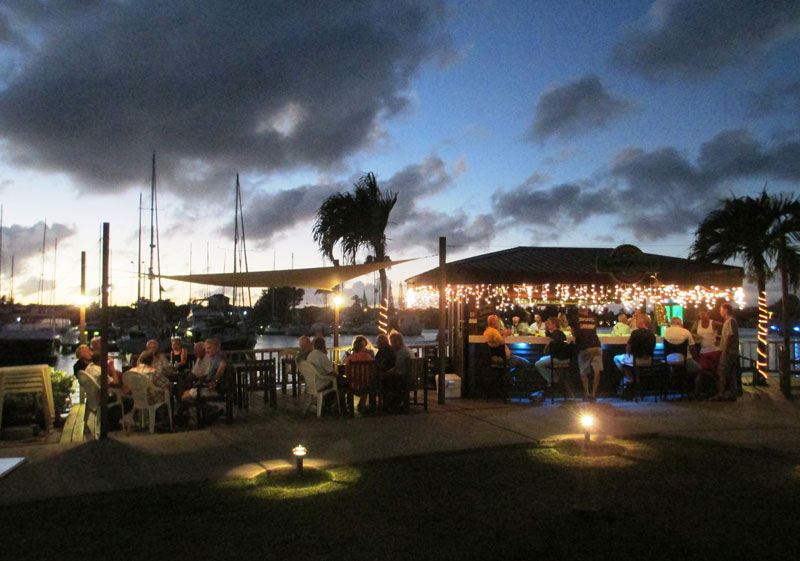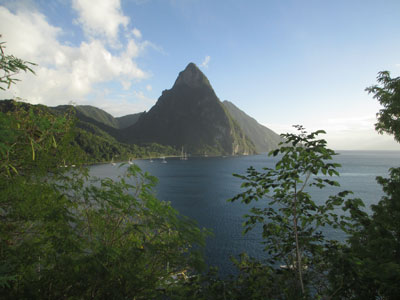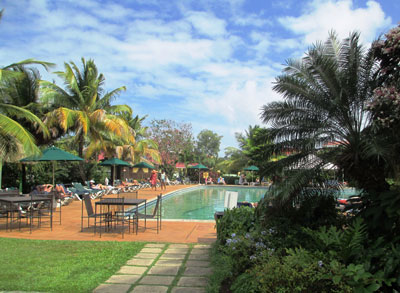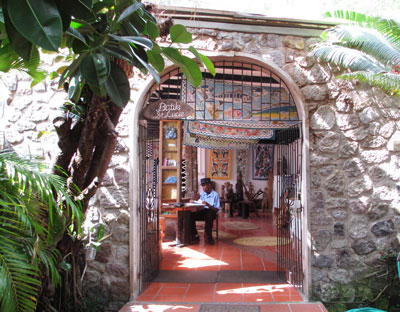Savoring the sun and the Creole soul of St. Lucia
This article appears on page 6 of the January 2015 issue.
In January 2014, my boyfriend, Frank, and I headed from Miami to St. Lucia, 238 square miles of beach and rainforest in the Lesser Antilles arc of the West Indies. This paradise, famed as a wedding destination, is said to offer a rich Creole culture.
Starting in Soufrière
Arriving at the Hewanorra International Airport on the southern tip of the island, we headed to Soufrière, located 40 minutes up the western coast. This town summoned us with its dramatic, front-seat view of the candy corn-shaped Gros Piton mountain.
Taxis proposed taking us to Soufrière for $50, but we chose to take one just to the nearby town, where shuttles could be found on the street. Welcoming us with a warm smile was the driver of a 15-person van, or bus, as it’s called locally. He accepted ECD8 ($3) per person, with our suitcases considered a third person.
The bus bounced north along winding roads lined with palm trees, banana trees and grazing horses. Zigzagging between the coast and the island’s interior, we traveled English style, on the left-hand side of the road.
Although English is the national language, passengers spoke to each other in St. Lucian Creole French, peppered with English, an interesting language reflecting the years of French and British colonization until the island achieved independence in 1979.
I loved the view from our backseat spot on the bus: riders with elaborately braided updos, dreadlocks, knit caps, radio earbuds and floral headbands all swaying to the beat of blaring reggae-rap as the bus raced along.
Arriving in Soufrière, the bus deposited us at the Downtown Hotel (Bridge & Frederick St.), which would serve as a base for scouting the town. Our room ($100 per night) was large, with an ocean view beyond a foreground of tin roofs plus loud waterfront activity below. The balcony was vast enough to enjoy coffee, books and morning yoga stretches. However, the hotel’s sewer system made the room less than ideal for a long-term stay.
Soufrière offers a vibrant, if occasionally gritty, view of local life. Winding streets, waterfront benches, an old church, painted murals and a park roamed by chickens made the stay interesting.
Women wore flowered flip-flops. Mannequins in windows had fuller figures than those in the US. Secluded high-end hotels sat hidden from view.
When rain came, as it did frequently (though it usually lasted only minutes), we stayed dry by pausing under awnings along with the locals.
New digs
The morning after our arrival, we found the Hummingbird Beach Resort (Anse Chastanet Rd.; www.hummingbirdbeachresort.com), situated a 15-minute walk away from downtown on the northern waterfront.
Conveniently set along the road to Anse Chastanet, a scenic beach where bicycles and snorkeling equipment can be rented, the Hummingbird offered a picturesque view from its pool and restaurant, angled toward Gros Piton rising from the sea. The lapping ocean and hummingbird whirls held our interest as we walked through the grounds, the faint scent of curry drifting by.
We decided to leave the Downtown Hotel and move to the Hummingbird for a week, where the cost of our basic room was $100 per night. There was nothing more pleasant than rising for our included breakfast and being greeted by an elegant dish of fruit slices: banana, soursop, papaya and mango. An array of hot breakfast choices followed.
The reception area (from the original house) exhibited photos of the owner, Joyce Alexander-Stowe, at Buckingham Palace in 2009 receiving the Order of the British Empire from Queen Elizabeth. This is a high honor recognizing distinguished service.
A colorful coastal town
Daily we walked to the market, bank, pharmacy, bakery, harbor and supermarkets. Residents greeted us with “Good morning,” and a kaleidoscope of music, people and vivid colors fed our appetite for a saucy Caribbean atmosphere.
There were few quiet corners. A man grilled conch outside his house, music blasting and neon lights flashing at twilight, as locals stopped in for a bite. At the end of the day, the Hummingbird awaited our return, with a quiet room and helpful staff.
We enjoyed the city’s botanical gardens, a climb on Gros Piton, a shuttle ride to Marigot Bay and a trip to the Friday fish fry in Anse La Raye. Nothing is far away on St. Lucia, though taxis can get expensive. We recommend negotiating the price in advance if public bus (shuttle) service is not available.
St. Lucians are helpful. When Frank experienced problems with the ATM, the bank assisted him in retrieving his money.
On another occasion, we got lost and faced spending the night in a town about 45 minutes away when we struck up a conversation with a woman awaiting a bus. She stayed with us until a bus that had room for the three of us came along.
Sunsets were charming from the beach behind the Hummingbird, where locals played soccer and swam in the fading light. I saw the famous yet elusive green flash of the sun just before it seemed to sink into the ocean.
We wish the government would put more money into Soufrière. An abandoned construction site on the beach next to the Hummingbird made some locals we spoke with unhappy. It seemed clear to us that Soufrière is not where tourist dollars are going.
Rodney Bay
After our week in Soufrière, we boarded a shuttle for the 90-minute ride north to Rodney Bay, which attracts most of the travelers to St. Lucia. The winding turns made me glad I didn’t have a full stomach.
The driver dropped us off in Castries, where we caught another bus heading farther north.
After a short ride, we got off at Rodney Bay Village, which is edged by a fabulous beach, with two shopping malls and large lodging properties in the outlying areas.
If the south is raw and rustic, the north is laid-back. I enjoyed people-watching while munching carrot cake from the Bonne Baguette Bakery.
Rodney Bay Village presented the kind of holiday experience we like: a cozy, low-rise community, pedestrian friendly and accessible to shops, restaurants and side trips.
La Terrasse (Gros Islet; www.la terrassestlucia.com), reminiscent of a private residence with tailored grounds, does double duty as a small hotel and a French restaurant, with a crème caramel to die for! Husband-and-wife team Thomas and Claudia, French-Norwegian and Guatemalan, welcomed us warmly.
Our spacious abode, the largest of four rooms priced at $100 per night, included plates, eating utensils and paper towels. The patio brought relaxation — the perfect location for travelers wishing to avoid a busy hotel.
One downside of La Terrasse is that no management is on site at night.
A nearby bar played loud music, a common problem in St. Lucia. I used earplugs — problem solved.
We walked 10 minutes to Reduit Beach, a long stretch of fine, white sand accessed through one of the waterfront hotels. The beach offered a warm welcome.
A man wearing a jet pack rose from the water while another motored on a jet ski. The sun set behind the bobbing boats and yachts, and the clear waters gleamed in the glowing light.
Moving on
After several days we moved to the nearby Coco Palm (877/655-2626; www.coco-resorts.com). This hotel, with rooms starting at approximately $130, offered a different yet equally satisfying experience. The pool formed the center of activity, bringing visitors together. Some of the rooms were “swim up.”
The breakfast buffet offered delicious fish cakes and fried bakes (fried breads) as well as bacon, sausage and omelets made to order.
We appreciated the wall murals depicting St. Lucian history.
A staffed tour desk stocked varied tour brochures, offering activities such as sailing excursions and a sugar plantation visit.
Daily visits to supermarkets connected us to the St. Lucian people. We filled our cart with banana chips, apples, yogurts, whole-wheat buns, cheese and bananas for snacking. Catching my eye at the Super J supermarket was a posted list of 52 virtues titled “The Gifts of Character,” which included Generosity, Integrity, Consideration and Joyfulness.
We relished the restaurants, most notably Razmataz (phone 758 452 9800, www.razmatazrestaurant.com), which offered Indian food and was festive, with gold-laced tablecloths, white latticework and high-back chairs. Like homing pigeons, we returned several times. The vegetarian biryani ($12) and accompanying sauce was excellent.
The hamburgers and fries (ECD42, or $15.50) at the Fire Grill (phone 758 451 4745, www.firegrillstlucia.com) hit the spot late one evening.
Rodney Bay shopping, though touted as a major attraction, offered little that tempted me away from the beach.
A short ride to the Rodney Bay Marina led to extraordinary views as yachters from around the world assembled for food and spirits in the setting sun. Most people take taxis to the marina, but we made the 20-minute walk as cars whizzed by.
There was no greater comfort than soaking in the serenity as we savored Café Ole’s pumpkin soup, a sandwich and salad. (Entrées cost ECD14-ECD30 each.) One afternoon we returned to a place just two doors down from Café Ole for scrumptious coconut ice cream.
Pigeon Island
We traveled to historic Pigeon Island National Landmark. The fort there was the site of numerous battles between France and Britain. Now, 44 acres of grass and rambling paths surround the garrison ruins.
A 15-minute uphill walk offered a stunning view of the demure Caribbean Sea where it met the thrashing Atlantic.
We explored our way back on foot, following Pigeon Island Beach as the coastline curved along the sparkling turquoise water.
When we approached a canal just past the Sandals Grande St. Lucian Spa & Beach Resort, a security guard came to our aid by ringing an old-fashioned bell, summoning another security guard in an inflatable dinghy to ferry us to the other side.
From there we continued on foot to Gros Islet, where we found our way to the Castries-Gros Islet Highway to catch the bus back to Rodney Bay.
A visit to Rodney Bay can be enriched by varied offerings, like snorkeling, sailing, sugar-to-rum-making tours and Gros Islet’s Friday night “jump up” of music and food, to name a few. Castries, a 15-minute ride away, is also of interest, with Derek Walcott Square, the harbor (sheltering mammoth cruise ships) and its famed market.
In Castries, we boarded the ferry to Martinique to experience yet another culture. However, we found the intra-island ferry transportation expensive (around $100 round trip) and not particularly customer friendly.
After touring Martinique, we ferried back to St. Lucia to enjoy it for another several days before shuttling down to the south for the airport.
Months later, one virtue from the “Gifts of Character” sign comes to mind as I think of that Creole haven: Joyfulness.




